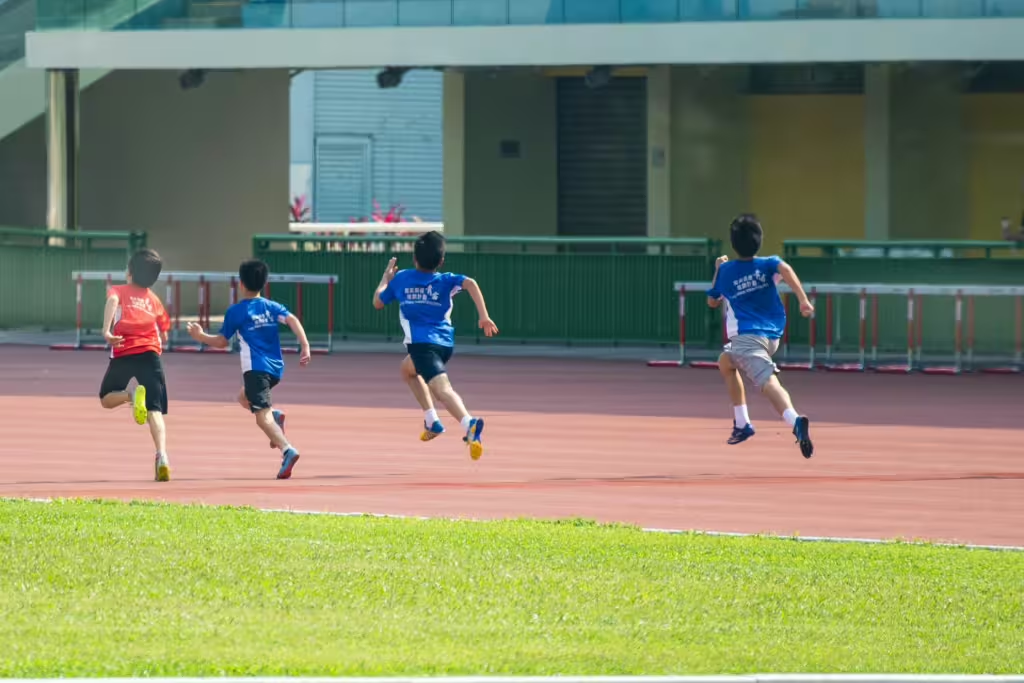Spring has finally sprung….at least in the Western hemisphere, anyway, and with it comes the promise of outdoor, youth sports. Spring is the season of growth and sunshine; i.e. the perfect time to get kids running, jumping, and moving anyway they can. And one of the best, most beneficial sports for them to do all of these things in, just happens to be track and field.
If your kids is one of those who is always bursting with energy, needs help with focus and coordination, or is simply looking for a chance to get out of the house and run around at practice a few times a week; then track and field is most definitely for them. Track may focus on individualized competition, but runners are still part of a team, so no matter what it’s a fun way to stay fit and make friends with other young athletes like themselves. The point is, even if your child isn’t the running type, track and field has something to offer them.
In this article, we will explore the many benefits of track and field offer young children. We will teach parents how they can get their child involved, the best ways to encourage consistent practice without being overbearing, and the best ways to help young athletes progress into more competitive levels as they grow. So lace up your trainers and get yourself to the starting line, the race is about to begin!
The Benefits of Track and Field for Kids
Track and field isn’t just about running faster than everyone else, if it was just a race, then it would probably not be considered an Olympic sport. Track and Field is, in essence, a series of different sports activities that, tother, represent a well-rounded sport that every child can enjoy, even from a young age. Not only that, but track and field can teach young athletes valuable life skills all while improving their physical health. Here are some of the top reasons why track and field represents a true parent-approved choice for young kids:

A Sport for Every Body
As we mentioned earlier, track and field offers up a wide variety of events for athletes to participate in: sprints, middle- and long-distance running, hurdles, relays, shot put, long jump, high jump, discus, and more. That means children of all shapes, sizes, and abilities can find something they enjoy and excel in. Some kids love the rush of sprinting down the track, while others prefer the technique and power of throwing events.
Builds Foundational Fitness
The truth is, track and field is an excellent all-around workout that helps lay the foundation for a lifetime of healthy movement. Moreover, it also happens to be easy enough for even the most uncoordinated, sports-shy kid to understand. There are no complicated rules, no complex plays, only sheer movement and the need to be just that much better than your opponents. Think about it, running, jumping, and throwing are fundamental movements for children. For most children, these things come as natural as breathing…or talking back. In any case, the actions a child practices while running track help them to develop:
- Cardiovascular health
- Muscle strength
- Agility and coordination
- Balance and flexibility
Encourages Goal Setting
Whether you want to admit it or not, the fact remains that track is a numbers sport. This means that athletes are expected to watch their times, distances, and form as they perform. This isn’t a bad thing, however, as it gives them a quantifiable way to see improvement over time. Believe it not, it can be highly motivating to see one’s own personal records get better each week. This type of behavior teaches discipline, patience, and the power of goal setting — traits that will ultimately extend far beyond the track.
Teaches Independence and Teamwork
While some events are meant for the individual and measure that player’s skills and physicality, there are some track and field event that involve other members of the team. For example, relays and team meets foster a sense of community amongst athletes. In many ways, the lack of direct communication during the course of “play” actually teaches athletes to cheer for one another, while supporting their teammates in whatever ways they can. This goes beyond simply taking pride in one’s personal progress, which we wholeheartedly admit is equally important.
Boosts Confidence
As children learn to meet personal goals or master a new skill — like a proper baton pass or a new jump technique — they gain confidence in their own abilities. In group events, they also learn that others have confidence in them, faith that they will do their part and get things done; this counts for a lot in the mind of a young athlete. And even if they do think too much about what others think of them (as did we all at that age) it is not a bad thing to know that one’s teammates have faith in you. Still, the fact remains that track doesn’t require scoring goals or beating an opponent to feel successful. Every child can have a “win” by just improving themselves.
How to Get Your Child Involved in Track and Field
If you’re a parent who is ready to introduce your child to track and field, we have a few easy, parent-friendly ways for you to get started:
Start With Play
Before diving into organized practices, it’s best to encourage simple backyard races, jumping contests, and games like relay tag. You want to see where your kid is at and these kinds of casual activities help children build familiarity with basic movements along with sparking interest in the sport itself.
Look for Local Youth Programs
Many communities have youth track and field programs that parents can find for their young athletes. Good sources to look into include:
- Local parks and recreation departments
- YMCA or Boys & Girls Clubs
- School-based track clubs (especially for middle schoolers)
- Independent youth track clubs affiliated with USATF (USA Track & Field) or AAU
Note that most of these programs typically group kids by age or ability, and many start as young as 5 or 6 years old. As one might expect from the timing of this article, spring and summer are the most common seasons for those looking to play youth track, though some areas also offer indoor winter programs.

Choose the Right Level
Track programs come in all shapes and sizes, goals and skill levels. While some programs are focused on skill-building and fun, others are more competitive and require greater commitment from kids and families alike. If you want to know more about the expectations of a particular program, talk to the coach or coordinator. Don’t be shy about your questions and don’t mince words. The point of this is to see what environment would work best for your child, and it’s especially pertinent if your kid is new to sports.
Check for “Try-It” Days
Some track clubs or schools host open houses or “trial” days. These events see interested parties trying different events, offering them a rare chance to explore what they enjoy most — whether that’s sprinting, jumping, or throwing.
Supporting Consistent Practice Without Pressure
Helping your child stay involved with track and field means encouraging healthy habits. That said, parents never want to be so overbearing that the sport feels like a chore. Here’s how to keep your kid’s track and field experience both fun and motivating:
Set Realistic Schedules
If your child is younger or new to sports, don’t overbook them. One or two practices per week is plenty for a kid at this level. As the child gets older or more serious, they might want to increase that — but even if they do, it should always be manageable. Balance is key to everything, especially when it comes to sports.
Celebrate Small Wins
Did they beat their own time by half a second? Celebrate that moment! How About perfecting a relay handoff? Give them a high five! Heck, even if they just finish a lap without stopping, you should congratulate them! The key to sports is confidence and kids gain confidence by understanding that progress is more important than perfection. It’s not easy to keep them on…track in this way, but do your best to remind them that even the smallest improvements indicate how far they have come.
Avoid Comparison
Track and field is one of the most personal sports out there, this means that your child has a rare opportunity to focus on their own growth rather than comparing themselves to others. Remind them that everyone develops at a different pace and that comparing themselves to their teammates or opponents is fruitless in the end.
Make Practice Fun
Here are some ideas you as a parent can use to help them practice at home and have fun doing it:
- Create mini obstacle courses in the backyard.
- Time family races down the street or at the park.
- Let your child design their own warm-up routine.
- Watch professional track events together to get inspired.
Provide the Right Gear
Track doesn’t have a lot of gear attached to it, but good running shoes, comfortable clothing, and water bottles are all essential pieces. These items go a long way in making practice enjoyable. If they’re involved in specific events like throwing or jumping, ask the coach about any other necessary equipment they might need that is not provided by the team or league.
Progressing to Competitive Levels as They Grow
If your child falls in love with track and field, there are a multitude of opportunities for them to compete and grow! Here’s how they can move forward:
Elementary and Middle School Meets
Many elementary and middle schools offer track programs and even those that don’t often partner with local youth leagues. Running at this level is more low-pressure than most other environments, and it gives kids time to learn competition basics like race pacing, lane rules, and sportsmanship.
USATF & AAU Events
For kids who want more serious competition, look into USA Track & Field (USATF) and Amateur Athletic Union (AAU) events. These organizations offer:
- Regional and national meets
- Age-based divisions (usually by 2-year intervals)
- A pathway to national-level recognition
Note that children can qualify for championships and even compete across the country as they get older and more experienced, so be ready for that kind of parental commitment on your part if they start showing interest, promise, or both.

High School Track
High school track offers a more structured and competitive environment. Young athletes train with coaches, participate in school-wide meets, and represent their teams in league championships. It’s a fun time and can really help a kid to make friends with their fellow athletes and students.
College and Scholarships
For dedicated athletes, college track can be the ultimate goal. Remember, colleges recruit talent based on event specialization, times, and performance. Now, only a small percentage of athletes go on to compete at the NCAA level, but that doesn’t mean you can count your kid out! Many colleges offer track as a club sport or intramural activity, which means college track is accessible to all skill levels.
The Olympic Dream
It might seem hard to believe when your third grader is tripping over their feet at the next track meet, but every Olympian once ran their first race in a similar way. While only a few reach elite international levels, the journey of growing through the sport is, in and of itself, quite meaningful. It is something you may want to remind your own child the next time they seem discouraged.
Cultured Athlete Says…
As you can see, track and field is more than just a sport — in many ways, it can be a journey of self-discovery. It is a tale that a child makes, written in movement, punctuated by skill, and concluded in growth and potential. Those who run track and field ultimately learn to push themselves past their self-imposed limits. At the same time, they also learn to work with others, to find joy in the shared triumphs of their trackmates, and to take pride in their improvements; no matter how slowly they come. As a parent, it falls to you to support them, encourage them, and be present at track meets whenever you can; such actions can make all the difference to a child. In the end, it doesn’t matter if your kid has dreams of Olympic gold or just wants to run with friends on a sunny afternoon; both reasons make track and field a path worth exploring. So get ready, because spring has sprung and the track meets of the coming season are calling your kid’s name!
Discover more from CulturedAthlete
Subscribe to get the latest posts sent to your email.






